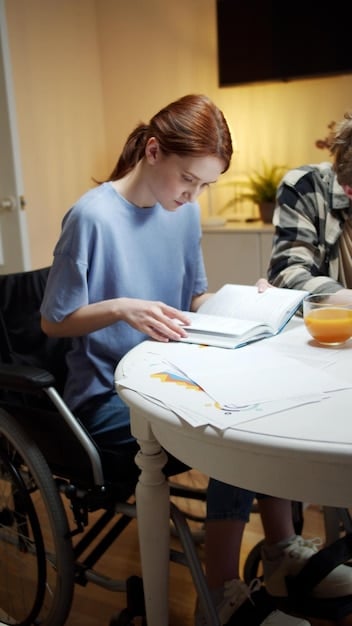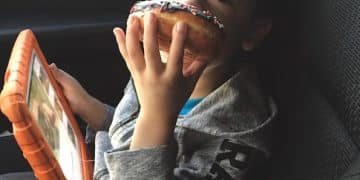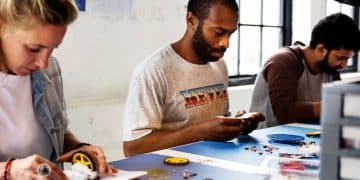US Special Education Guide 2025: IEPs, 504 Plans & Support

This comprehensive guide for 2025 details essential US special education resources, offering clear insights into navigating Individualized Education Programs (IEPs), understanding 504 Plans, and accessing crucial support services for students with diverse learning needs.
Navigating the landscape of special education in the United States can often feel like a complex journey, particularly when seeking the best resources and support for a child with unique learning requirements. This guide, “The Ultimate Guide to US Special Education Resources: Navigating IEPs, 504 Plans, and Support Services in 2025,” aims to demystify the process, illuminating the pathways to effective educational assistance.
Understanding Special Education Law and Your Rights
The foundation of special education in the United States lies within federal legislation designed to protect the rights of children with disabilities and ensure they receive a Free Appropriate Public Education (FAPE). This legal framework shapes how schools must identify, assess, and serve students with diverse needs.
Two primary federal laws govern special education: the Individuals with Disabilities Education Act (IDEA) and Section 504 of the Rehabilitation Act of 1973. While both aim to prevent discrimination and guarantee access to education, they differ significantly in their scope and the types of services they mandate.
The Individuals with Disabilities Education Act (IDEA)
IDEA is a comprehensive federal law that ensures all children with disabilities have access to a FAPE in the least restrictive environment. It covers children from birth through age 21 and specifies 13 categories of disability that qualify a child for special education services. These categories range from autism and specific learning disabilities to speech or language impairments and emotional disturbances.
Key provisions of IDEA include:
- Child Find: Schools must identify, locate, and evaluate children suspected of having disabilities.
- Individualized Education Program (IEP): A written plan developed for each child receiving special education services, outlining their specific educational goals and the services they will receive.
- Least Restrictive Environment (LRE): Children with disabilities must be educated with non-disabled peers to the maximum extent appropriate.
- Parental Rights: Parents have extensive rights, including participation in decision-making, access to records, and dispute resolution opportunities.
Understanding these fundamental rights under IDEA is crucial for any parent or guardian advocating for a child in need of special education support. It empowers families to actively participate in their child’s educational journey and hold schools accountable.
Section 504 of the Rehabilitation Act of 1973
Section 504 is a civil rights law that prohibits discrimination against individuals with disabilities in programs and activities receiving federal financial assistance, including public schools. Unlike IDEA, Section 504 does not provide funding for special education services, but it ensures that students with disabilities have equal access to education.
A child qualifies for a 504 Plan if they have a physical or mental impairment that substantially limits one or more major life activities, such as learning, walking, seeing, hearing, or breathing. The focus of a 504 Plan is to provide accommodations that level the playing field, allowing the student to participate in the general education curriculum. These accommodations might include extended time on tests, preferential seating, or reduced homework assignments.
While an IEP is a highly individualized educational roadmap, a 504 Plan focuses more on access and accommodations within the general education setting. Both are vital tools, but their application depends on the specific needs and qualifying criteria of the student.
Navigating Individualized Education Programs (IEPs)
For many families, the IEP is the cornerstone of their child’s special education journey. It is a legally binding document that details a student’s current performance, sets annual goals, and specifies the special education and related services they will receive. The process of developing an IEP is collaborative, involving parents, educators, and other relevant professionals.
The IEP Process: From Referral to Review
The IEP process typically begins with a referral, which can come from a parent, teacher, or other school personnel. Once a referral is made, the school has a specific timeframe to conduct a comprehensive evaluation to determine if the child qualifies as a “child with a disability” under IDEA.
Should the evaluation identify a disability, an IEP team meeting is scheduled. This team includes the parents, at least one general education teacher, at least one special education teacher, a school district representative, and an individual who can interpret the instructional implications of evaluation results. Depending on the child’s needs, other professionals like therapists or psychologists may also be present.

During the meeting, the team reviews the evaluation results, discusses the child’s strengths and challenges, and collaboratively develops the IEP document. This document outlines measurable annual goals, the special education services to be provided, any necessary accommodations or modifications, and the extent to which the child will participate with non-disabled peers.
Key Components of an Effective IEP
An effective IEP is a living document, evolving with the child’s needs. It should contain several critical components to ensure the child receives appropriate support and makes meaningful progress. These include:
- Present Levels of Academic Achievement and Functional Performance (PLAAFP): A detailed summary of how the child’s disability affects their involvement and progress in the general education curriculum.
- Measurable Annual Goals: Specific, measurable, achievable, relevant, and time-bound goals that the child is expected to achieve within a year. These often cover academic, social, behavioral, or functional skills.
- Special Education and Related Services: A clear description of the specific services, interventions, and therapies the child will receive, such as specialized instruction, speech therapy, occupational therapy, or counseling.
- Accommodations and Modifications: Changes to how a child learns or is tested (accommodations) or changes to what a child is taught or expected to learn (modifications).
- Placement: A statement of the educational setting where the child will receive services, ensuring the least restrictive environment.
Parents play a vital role in ensuring these components are accurately reflected and effectively implemented. Their insights into their child’s daily life and learning patterns are invaluable to the IEP team.
Advocating for Your Child’s IEP
Effective advocacy is paramount in the IEP process. Parents are equal members of the IEP team and have the right to voice concerns, ask questions, and propose changes to the IEP. Being prepared for IEP meetings can significantly impact the outcome.
Consider these advocacy strategies:
- Educate Yourself: Understand IDEA and your rights as a parent.
- Document Everything: Keep written records of all communication with the school, meeting notices, and progress reports.
- Request Data: Ask for data that supports the child’s progress or lack thereof.
- Bring Support: You can bring an advocate, a friend, or another family member to IEP meetings for support.
Remember, the goal is to create an IEP that genuinely meets your child’s needs and fosters their academic and functional development. Don’t hesitate to seek clarification or express disagreement if you believe the plan is not appropriate.
Understanding Section 504 Plans
While often compared to IEPs, Section 504 Plans serve a distinct, yet equally important, role in providing support to students with disabilities. It’s crucial for parents to understand the differences and determine which plan is appropriate for their child’s specific circumstances.
Eligibility and Purpose of a 504 Plan
A child is eligible for a 504 Plan if they have a physical or mental impairment that substantially limits one or more major life activities. This broad definition can encompass a wide range of conditions, from ADHD and migraines to anxiety or diabetes, that may not qualify for services under IDEA but still impact the child’s ability to access education equally.
The primary purpose of a 504 Plan is to ensure that a student with a disability has equal access to the general education curriculum and school activities. This is achieved through the provision of reasonable accommodations designed to “level the playing field.” Unlike an IEP, a 504 Plan does not require a student to need specialized instruction; rather, it focuses on modifying the learning environment or instructional methods to remove barriers.
For example, a student with a nut allergy might have a 504 Plan detailing how the school will ensure a safe environment, while a student with a processing disorder might receive extended time on tests. The key distinction is that 504 Plans prevent discrimination and ensure accessibility, rather than providing specialized instruction.
Developing and Implementing a 504 Plan
The process for developing a 504 Plan is generally less formal than for an IEP. It typically involves a team that includes the parents, teachers, and other relevant school staff. This team determines if the student meets the Section 504 criteria and what accommodations are necessary.
Once developed, the 504 Plan outlines the specific accommodations that will be provided. These accommodations should be clearly articulated and understood by all staff members who interact with the student. Regular communication between parents and the school is vital to ensure the plan is being effectively implemented and remains appropriate as the child’s needs evolve.
When to Consider a 504 Plan vs. an IEP
Deciding between a 504 Plan and an IEP can be challenging for parents. The primary differentiator is the need for specialized instruction. If a child requires specially designed instruction to make progress in the general education curriculum, an IEP under IDEA is likely the appropriate pathway. If a child can learn in the general education setting but needs accommodations to access that learning due to a disability, a 504 Plan is more suitable.
It is not uncommon for a child to initially have a 504 Plan and later, as their needs change or become more complex, transition to an IEP. Conversely, some students may “declassify” from an IEP and move to a 504 Plan if they no longer require specialized instruction but still benefit from accommodations.
Parents should work closely with school officials, and potentially seek independent advice, to determine the most appropriate support plan for their child, always keeping the child’s individual needs and educational goals at the forefront.
Essential Support Services Beyond IEPs and 504s
While IEPs and 504 Plans are cornerstones of special education, a wealth of additional support services and organizations exist to bolster the educational and developmental journeys of children with disabilities. Understanding and accessing these resources can significantly enhance a child’s school experience and overall well-being.
Related Services and Supplementary Aids
Under IDEA, “related services” are those that a child with a disability needs to benefit from special education. These are not instruction themselves but are crucial for a child to access their education. Common related services include:
- Speech-Language Pathology: Services to address communication disorders.
- Occupational Therapy (OT): Helps with fine motor skills, sensory processing, and daily living activities.
- Physical Therapy (PT): Addresses gross motor skills and physical mobility.
- Counseling Services: Provides support for social, emotional, and behavioral challenges.
- Transportation: Specialized transportation if needed due to disability.
- School Health Services: Nursing services or other health-related support at school.
In addition to related services, “supplementary aids and services” are provided in general education settings to enable children with disabilities to be educated with non-disabled children to the maximum extent appropriate. These might include preferential seating, assistive technology, paraprofessional support, or adjusted assignments.
Assistive Technology (AT)
Assistive technology is any item, piece of equipment, or product system, whether acquired commercially, modified, or customized, that is used to increase, maintain, or improve functional capabilities of a child with a disability. AT can range from low-tech solutions like pencil grips or visual schedules to high-tech devices like communication aids or screen readers.
The IEP team must consider a child’s need for assistive technology. If AT is determined necessary, it must be provided as part of the special education services. Proper evaluation, training, and ongoing support are essential for AT to be effective in helping a student access the curriculum and thrive academically.
Parent Training and Information Centers (PTIs)
Across the United States, Parent Training and Information (PTI) Centers are federally funded resources dedicated to providing parents of children with disabilities with the information and skills they need to advocate effectively for their children. PTIs offer a variety of services, including:
- Providing information about IDEA, Section 504, and other relevant laws.
- Assisting parents in understanding their child’s disability and educational needs.
- Guidance on navigating the special education system, including IEP and 504 meetings.
- Training workshops on topics such as effective communication with school personnel, dispute resolution, and transition planning.
Connecting with your local PTI can be an invaluable step for parents seeking to empower themselves with knowledge and support. These centers often serve as a first point of contact for families entering the special education system.
Transitional Services and Post-Secondary Planning
As students with disabilities approach their final years of high school, the focus shifts towards preparing them for life after graduation. Transitional services are a critical component of special education, designed to facilitate a smooth and successful transition to post-secondary education, vocational training, employment, independent living, or community participation.
Transition Planning within the IEP
Under IDEA, transition planning must begin no later than the first IEP to be in effect when the student turns 16, or younger if determined appropriate by the IEP team. This process involves a coordinated set of activities for a student with a disability, designed to be results-oriented and focused on improving the academic and functional achievement of the student. The ultimate goal is to facilitate the student’s movement from school to post-school activities.
The IEP team, including the student and their parents, identifies individualized post-secondary goals related to education, employment, and independent living. Based on these goals, the team develops a plan that includes instruction, related services, community experiences, and the development of employment and other post-school adult living objectives. It can also include acquisition of daily living skills and functional vocational evaluation.

Student involvement in this process is crucial, fostering self-determination and empowering them to take ownership of their future. Exploring various post-secondary options and understanding necessary preparations are key during these years.
Post-Secondary Education and Vocational Training
Many students with disabilities pursue higher education or vocational training after high school. Colleges and universities are obligated under Section 504 and the Americans with Disabilities Act (ADA) to provide reasonable accommodations to students with disabilities. However, advocacy shifts from the school district to the student, who must disclose their disability and request accommodations.
Resources available for post-secondary planning include:
- OVR (Office of Vocational Rehabilitation): Provides services to help individuals with disabilities prepare for, obtain, and maintain employment.
- Higher Education Disability Services: Most colleges have offices dedicated to supporting students with disabilities, offering accommodations, and academic support.
- Specialized Programs: Some universities offer programs specifically designed for students with intellectual disabilities or autism spectrum disorder.
Early exploration of these options ensures that students and families are well-prepared for the transition to a new educational or training environment.
Employment and Independent Living
For students transitioning directly into employment or independent living, transition planning addresses the development of practical skills. This might include vocational training, job coaching, independent living skills instruction (e.g., budgeting, cooking, public transportation use), and referrals to adult service agencies.
Community integration is also a significant aspect, ensuring students have access to resources and activities that promote their independence and quality of life. The aim is to equip students with the necessary tools and support to lead fulfilling and self-sufficient lives beyond the K-12 system. Working with the IEP team to connect with adult service agencies and community programs is a proactive step toward successful post-school outcomes.
Leveraging Community and Online Resources in 2025
Beyond the formal frameworks of IEPs and 504 Plans, a vast ecosystem of community and online resources can provide invaluable support to students with disabilities and their families. Staying informed about these resources can make a profound difference in a child’s educational journey and overall well-being.
Connecting with Local and National Advocacy Groups
Advocacy groups play a crucial role in shaping policy, sharing information, and providing support networks for families. National organizations like The Arc, United Cerebral Palsy (UCP), and associations dedicated to specific disabilities (e.g., Autism Speaks, National Association for Down Syndrome) offer extensive resources, including:
- Information on best practices in education and therapies.
- Advocacy tools and legal guidance.
- Support groups for parents and individuals with disabilities.
- Research updates and legislative initiatives.
Many of these national organizations also have local chapters, providing more tailored support and networking opportunities within specific communities. Engaging with these groups can offer a sense of community and access to shared experiences and knowledge.
Online Platforms and Digital Connects
The digital age has revolutionized access to information and support. Numerous online platforms and communities are dedicated to special education resources. These include:
- Government Websites: Sites like the U.S. Department of Education’s Office of Special Education Programs (OSEP) offer official guidelines, research, and data.
- Non-profit Resource Hubs: Websites from organizations like Understood.org and ADDitude provide articles, webinars, and expert advice on various learning and attention issues.
- Parent Forums and Social Media Groups: Online communities where parents share experiences, ask questions, and offer peer support. These can be particularly valuable for discussing practical strategies and navigating day-to-day challenges.
- Educational Technology Platforms: Tools and applications designed to support specific learning needs or provide accessible content.
Careful vetting of online sources is always advisable to ensure the information is accurate and reliable. Look for reputable organizations and experts in the field.
Local Community Programs and Therapies
Beyond school-based services, local communities often offer a range of programs and therapies that can complement a child’s educational plan. These might include:
- Private Therapy Practices: Speech, occupational, or physical therapy clinics that offer services outside of school hours.
- Recreation Programs: Adaptive sports leagues, art classes, or music therapy designed for individuals with disabilities.
- After-School Programs: Homework help, tutoring, or social skills groups specifically for students with learning differences.
- Support Groups: For parents, siblings, or the students themselves, offering a safe space to share experiences and coping strategies.
Exploring these local options can provide additional interventions, enrichment activities, and social opportunities that enhance a child’s development and quality of life. Many schools and parent groups often maintain lists of recommended community resources, which can be an excellent starting point for discovery.
Future Trends in Special Education (2025 and Beyond)
The field of special education is continuously evolving, driven by research, technological advancements, and a deeper understanding of diverse learning needs. Looking towards 2025 and beyond, several key trends are likely to shape how special education is delivered and experienced.
Personalized Learning and AI Integration
The movement towards personalized learning, where instruction is tailored to individual student needs and learning styles, will continue to gain traction. Artificial Intelligence (AI) and machine learning are poised to play a transformative role in this process. AI-powered platforms can adapt curriculum, provide immediate feedback, identify learning patterns, and even predict potential areas of difficulty, allowing educators to intervene proactively.
For students with special needs, AI could mean highly customized learning pathways, intelligent tutoring systems, and enhanced accessibility features that adapt to their specific challenges. However, ensuring equitable access to these technologies and addressing data privacy concerns will be critical.
Inclusive Practices and Neurodiversity Affirmation
There’s a growing emphasis on truly inclusive education, where students with disabilities are not just present in general education classrooms but are fully participating members of the learning community. This involves shifting mindsets, providing robust professional development for all educators, and designing universally accessible learning environments.
Furthermore, the concept of neurodiversity is gaining broader acceptance, viewing neurological differences (like autism, ADHD, dyslexia) as natural human variations rather than deficits to be cured. This perspective encourages celebrating diverse strengths and creating supportive environments that affirm and leverage these unique ways of thinking and learning.
Telehealth and Remote Support Services
The expansion of telehealth, particularly accelerated by recent global events, is likely to become a more permanent fixture in special education. Remote delivery of related services like speech therapy, occupational therapy, and counseling can increase accessibility, especially for students in rural areas or those with mobility challenges. While in-person services remain vital, telehealth offers flexibility and a broader reach for expert support.
Similarly, remote parent training and support groups can extend their reach, allowing more families to access valuable information and connect with peers regardless of geographical barriers. This trend emphasizes the importance of hybrid models of service delivery.
Increased Focus on Mental Health and Social-Emotional Learning
There’s a heightened awareness of the significant mental health challenges often faced by students with disabilities. Future trends will likely include a greater integration of mental health supports within school systems, proactive social-emotional learning (SEL) programs, and partnerships with community mental health providers.
Addressing anxiety, depression, and other co-occurring conditions is crucial for academic success and overall well-being. Schools will increasingly look for holistic approaches that support not only academic growth but also the emotional resilience and social competencies of all students, particularly those with special needs.
Future-Proofing Your Child’s Special Education Journey
As we navigate the evolving landscape of US special education resources in 2025 and beyond, proactive engagement and informed decision-making remain paramount. The cornerstone of a successful educational journey for a child with special needs lies in understanding the available frameworks, advocating effectively, and leveraging both formal and informal support systems. Remaining adaptive to new technologies and embracing an inclusive mindset will empower families and educators to create truly supportive and enriching learning environments.
| Key Point | Brief Description |
|---|---|
| 📚 IEPs vs. 504s | IEPs provide specialized instruction under IDEA; 504 Plans offer accommodations for equal access under civil rights law. |
| 🤝 Parent Advocacy | Parents are key members of special education teams; informed advocacy is crucial for effective support. |
| 🌐 Diverse Resources | Beyond school services, community groups, online platforms, and related therapies offer holistic support. |
| 🚀 Future Trends | Personalized learning, AI, inclusion, telehealth, and mental health integration will shape future special education. |
Frequently Asked Questions About Special Education
An IEP (Individualized Education Program) is for students who require specialized instruction due to a disability under IDEA. A 504 Plan provides accommodations for students with disabilities who need equal access to education but not specialized instruction, falling under Section 504 of the Rehabilitation Act.
Begin by making a formal written request to your child’s school for an evaluation. The school is then obligated to assess your child to determine if they qualify for special education services under federal law, initiating the IEP or 504 Plan process.
“Related services” are supportive services necessary for a child with a disability to benefit from special education. These can include speech-language pathology, occupational therapy, physical therapy, counseling services, and transportation, all tailored to meet the child’s specific educational needs.
Yes, an IEP is a dynamic document that can be reviewed and revised at any time, typically at least once a year. Parents can request an IEP meeting to discuss changes if they believe the child’s needs have evolved or the plan is not effectively addressing their educational requirements.
Transition planning is integrated into the IEP, starting by age 16, focusing on post-secondary goals for education, employment, and independent living. Resources include Vocational Rehabilitation, college disability services, and community programs, all designed to facilitate a smooth move into adult life.
Conclusion
Navigating the complex, yet profoundly important, world of special education in the US demands a blend of understanding, advocacy, and resourcefulness. Whether it involves deciphering the nuances of an IEP, leveraging the accommodations of a 504 Plan, or tapping into the broader spectrum of support services, empowering students with disabilities is a collective endeavor. By staying informed, actively participating in decision-making, and embracing emerging trends in educational support, parents and educators can collaboratively ensure every child has the opportunity to achieve their fullest potential in 2025 and beyond.





